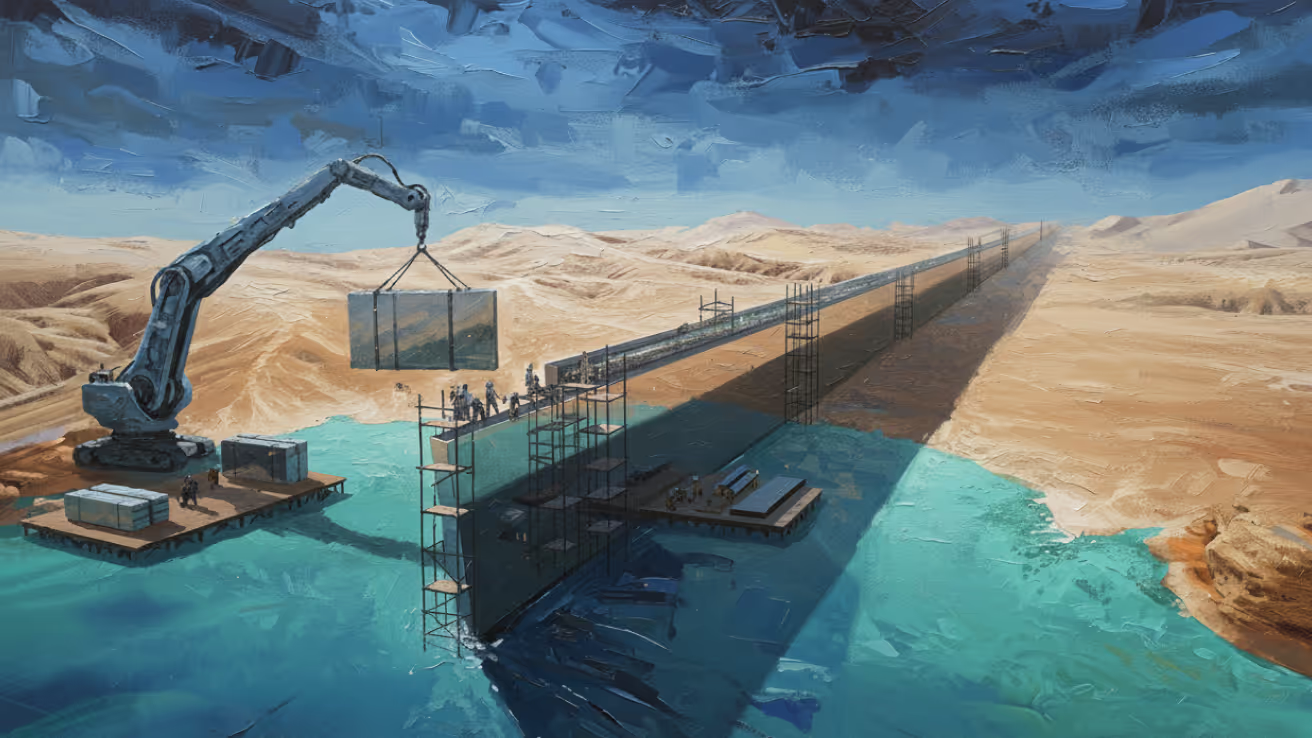
Saudi Arabia's ambitious NEOM project, a $500 billion smart city rising from the desert, has taken another significant step forward with the NEOM Investment Fund (NIF) making a strategic investment in Europe's GMT Robotics. As construction accelerates on The Line megacity, Epicon twin skyscrapers, and other jaw-dropping architectural projects, robotics is emerging as a critical enabler of NEOM's impossible timeline and unprecedented scale.
NEOM represents one of the most audacious urban development projects in human history. Spanning 26,500 square kilometers along Saudi Arabia's Red Sea coast, NEOM is envisioned as a carbon-neutral economic zone powered entirely by renewable energy, incorporating flying taxis, artificial rain, holographic teachers, and a glowing artificial moon. The centerpiece, The Line, is a 170-kilometer-long linear city designed to house 9 million residents without cars, streets, or carbon emissions.
Building this vision requires construction techniques and capabilities that simply don't exist today, which is precisely why NEOM is investing heavily in robotic automation.
The Construction Challenge
Traditional construction methods won't suffice for NEOM's ambitions. The project demands:
Robotic construction systems address each of these challenges. Robots don't tire in extreme heat, can work 24/7, perform repetitive tasks with perfect consistency, and can be programmed to optimize material usage and minimize waste.
GMT Robotics' Capabilities
While specific details of GMT Robotics' technology haven't been fully disclosed, European construction robotics generally focus on several key applications:
Automated Bricklaying: Robotic systems can lay bricks faster and more precisely than human workers, with perfect consistency over thousands of repetitions. Some systems can complete in a day what would take a crew of workers a week.
Welding and Fabrication: Robotic welding provides consistent quality crucial for structural steel applications, particularly important for NEOM's innovative architectural designs.
Material Handling: Autonomous robots transport materials around construction sites, reducing the need for cranes and manual labor in hazardous environments.
3D Printing: Robotic 3D printing of building components, from concrete structures to architectural details, enables custom designs without the tooling costs of traditional manufacturing.
Quality Inspection: Vision-equipped robots scan completed work for defects, ensuring compliance with specifications and identifying issues before they become costly problems.
The NEOM Integration
NEOM's investment in GMT Robotics isn't just about buying robots, it's about integrating robotic capabilities into a broader ecosystem of construction innovation. NEOM is building:
Digital Twin Infrastructure: Virtual replicas of all construction projects enabling simulation, optimization, and coordination before breaking ground
AI-Driven Logistics: Intelligent systems orchestrating material delivery, equipment deployment, and workforce allocation across thousands of concurrent activities
Cyber-Physical Systems: Connecting robotic systems, IoT sensors, and AI analytics for real-time construction monitoring and adaptive planning
Smart Construction Sites: 5G-connected sites where robots, drones, workers, and management systems communicate seamlessly
Autonomous Equipment: Self-driving excavators, trucks, and other heavy equipment coordinating activities without human operators
This level of integration requires substantial investment in both technology and the partnerships needed to bring it together, which is exactly what NEOM's investment in GMT Robotics represents.
The Business Case
While NEOM's $500 billion budget is staggering, the project's backers are keenly focused on efficiency. Robotic construction offers multiple financial advantages:
Labor Cost Reduction: Robots working around the clock reduce per-unit construction costs despite significant capital investment
Speed: Faster construction means earlier revenue generation from completed facilities and reduced financing costs
Quality: Consistent quality reduces rework, warranty claims, and lifecycle maintenance costs
Safety: Fewer workplace injuries reduce liability, insurance costs, and project delays
Precision: Accurate construction reduces material waste, critical both for cost control and NEOM's sustainability goals
The Regional Impact
NEOM's embrace of construction robotics will ripple across the Middle East. As the technology proves itself at scale, expect to see adoption by other mega-projects in Saudi Arabia, the UAE, Qatar, and beyond. The Gulf region has no shortage of ambitious construction projects, and all face similar challenges around speed, scale, and labor availability.
Moreover, NEOM's investment could establish Saudi Arabia as a hub for construction robotics innovation. As local expertise develops and supply chains mature, the kingdom could export these capabilities regionally and globally, another example of Vision 2030's economic diversification strategy.
Challenges Remain
Despite the promise, integrating robotics into construction at NEOM's scale presents significant challenges:
Desert Environment: Extreme heat, sandstorms, and harsh conditions test robotics systems designed for European construction sites
Coordination Complexity: Thousands of robots working across vast construction zones require sophisticated coordination systems
Skill Development: Training Saudi workers to operate, maintain, and manage robotic systems requires substantial investment in education
Technology Maturity: Some required capabilities are still in development and may not be ready for full-scale deployment
Regulatory Framework: Construction codes and regulations designed for traditional methods may need updating for robotic construction
Looking Ahead
As GMT Robotics' systems deploy across NEOM's construction sites in coming months, the world will be watching. Success could accelerate the adoption of construction robotics globally, while challenges could provide valuable lessons for other mega-projects.
What's certain is that NEOM represents a proving ground for next-generation construction methods. The combination of ambitious vision, substantial funding, and willingness to embrace emerging technologies makes it an ideal testbed for innovations that could transform how humanity builds its cities.
The robots are coming to construction and they're starting in the Saudi desert.